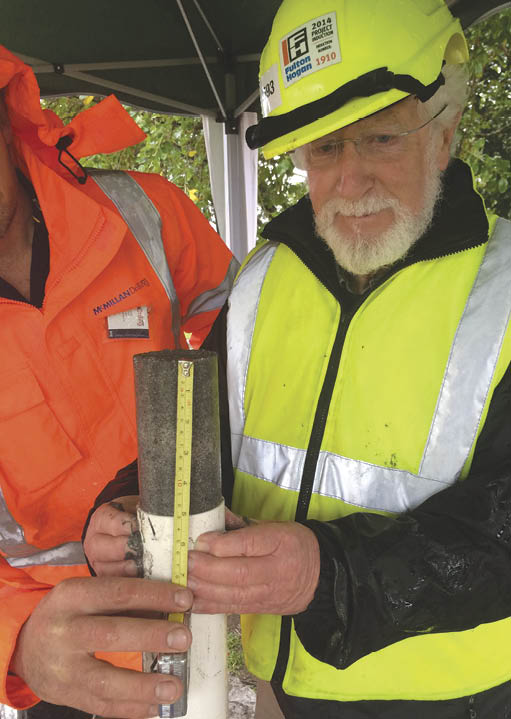Pumiceous deposits exist in many areas of the North Island, and pose a particular challenge to engineering projects due to the difficulties associated with characterizing these materials. Key characteristics of pumice grains are their high crushability, their low density and the presence of voids, both internally and on the surface of the grains. Each of these characteristics has important consequences for assessing the response of the material to different loading conditions. In particular, it has been shown by Wesley et al (1999) that the penetration resistance measured during a CPT sounding is insensitive to relative density in pure pumice material. This result clearly shows that extreme caution must be exercised when attempting to estimate engineering properties from correlations which have been developed for hard-grained materials. Additionally, element testing reported by Orense et al. (2012) has shown that there are some important differences between the behaviour of purely pumiceous material when compared with hard-grained materials of similar size.
While laboratory studies have shown clear issues in the characterisation of pumiceous soils, it is important to recognize that the previously described results apply to reconstituted samples of poorly graded pumice. Naturally occurring pumiceous deposits on the other hand are often well-graded, mixed with hard-grained materials, and affected by factors such as fabric, structure, ageing and stress history. As such, undisturbed sampling has a key role to play in establishing in advancing our understanding the behaviour of these materials as they exist in-situ.
Downhole undisturbed sampling of sandy material is notoriously difficult, and experience from Japan has shown that conventional samplers (i.e. push tubes and core-samplers) can significantly disturb samples such that they may no longer represent the in-situ characteristics of the soil (i.e. Yoshimi et al. 1994). With this in mind, the authors are attempting to establish the relative performance of three advanced sampling tools and conventional push-tubes in retrieving high quality specimens of pumiceous material.
The three “advanced” soil samplers being trialled in this study are the Dames and Moore (DM) fixed piston sampler, the Gel-Push Static (GP-S) fixed piston sampler and the Gel-Push Triple Tube (GP-TR) rotary sampler. These samplers have been used in a number of field trials in Christchurch since the 2010-2011 earthquakes to recover undisturbed samples of silty sands, with some promising results (i.e. Taylor et al. 2012, Stringer et al. 2015). Each of these samplers have incorporated features into their design to reduce the sidewall friction (thought to be a major source of sampling disturbance) which acts on the side of the soil specimen as it is captured within the tool; the DM sampler uses relatively short brass tubes, while the Gel-Push samplers coats the soil sample in a lubricating polymer gel.
A suitable site for trialling the samplers was located near the central business district of Whakatane. At this site, relatively thick, shallow pumice bearing layers were noted in a logged borehole. The pumice bearing materials could be separated into two representative cone penetration resistances: 2MPa and 6 MPa. Based on the experience with the field trials in Christchurch, this range in penetration resistance was deemed suitable for testing the performance of the different samplers.
The undisturbed sampling was carried out in late September by McMillan Drilling and a team of researchers from both the University of Auckland and University of Canterbury (Figures 1-3). A total of 4 boreholes (spaced 2m apart) were drilled to enable samples to be obtained with each sampler from identical depths below the ground surface. Following retrieval, the samples were allowed to drain overnight before being frozen and transported back to the university laboratories where an evaluation of sample quality will be undertaken in the near future (an example section of a frozen GP-TR specimen is shown in Figure 4).


Figure 1: Preparing the GP-S sampler

Figure 2: Careful retrieval of soil samples

Figure 3: On-site extrusion of soil specimen. (for visual assessment only)

Figure 4: Example section of sample recovered using the GP-TR sampler (after freezing).
It is anticipated that this research will highlight the scenarios under which it may be possible to obtain high quality samples of pumiceous material using the samplers trialled in this study. This information will be used to optimise future sampling attempts in these soils, which in the short term will be beneficial in determining key engineering properties of specific deposits, while in the longer term, results can be combined to develop new frameworks for site characterisation based on simple field tests using tools such as the CPT.
In the coming years, the authors hope to carry out undisturbed sampling at a number of sites with pumiceous deposits as we seek to build a database of results. As part of this effort, we welcome engagement from our colleagues in industry who may be interested in performing detailed characterisation of pumiceous deposits on their specific projects.
References
Wesley, L., Meyer, V., Pranyoto, S., Pender, M., Larkin, T. & Duske, G. (1999) Engineering properties of a pumice sand. Proc. 8th ANZ Conf. Geomechanics
Stringer, M.E, Beyzaei, C.Z., Cubrinovski, M., Bray, J.D., Riemer, M., Wentz, F.P. (2015) “Liquefaction Characteristics of Christchurch Silty Soils: Gainsborough Reserve,” in Proc. 6th Int Conf. Earthquake Geotechnical Engineering, Christchurch
Taylor, M.L., Cubrinovski, M. & Haycock, I. (2012) Application of new ‘Gel-push’ sampling procedure to obtain high quality laboratory test data for advanced geotechnical analyses. In proc. 2012 NZSEE Conference. Paper No. 123
Orense, R.P., Pender, M.J. and O’Sullivan, A. (2012). “Liquefaction Characteristics of Pumice Sands,” Final Report of EQC Project 10/589, 131pp.
Yoshimi, Y., Tokimatsu, K. & Ohara, J. (1994) In situ liquefaction resistance of clean sands over a wide range in density. Geotechnique. 44(3):479-494
Orense, R.P., Pender, M.J. and O’Sullivan, A. (2012). “Liquefaction Characteristics of Pumice Sands,” Final Report of EQC Project 10/589, 131pp.
Yoshimi, Y., Tokimatsu, K. & Ohara, J. (1994) In situ liquefaction resistance of clean sands over a wide range in density. Geotechnique. 44(3):479-494
